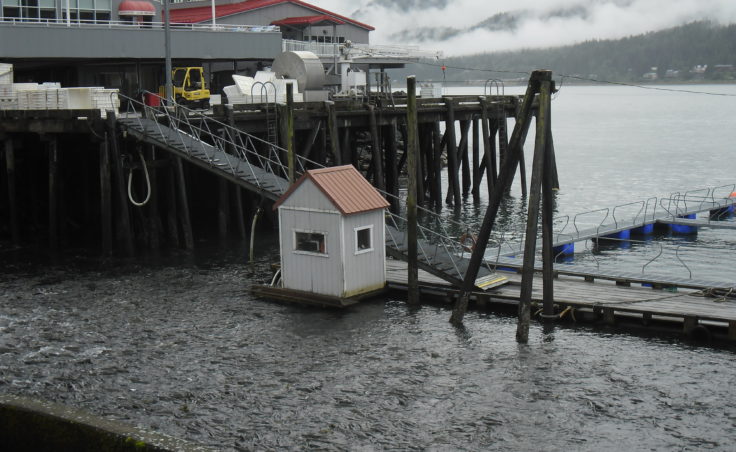For the first time since it started in 1976, Douglas Island Pink and Chum – better known as DIPAC – is operating in the black. The salmon hatchery recently finished paying back 42 million dollars of loans and interest, and is getting more salmon to the commercial fishing fleet than ever before.
DIPAC rears and releases chum, coho, sockeye, and chinook, but chum salmon is the organization’s main species for recovering operational costs. KTOO News recently visited DIPAC’s Macaulay facility to watch the process of chum salmon egg taking.
Thousands of chum salmon are swimming up the DIPAC fish ladder this week. They began their life at this facility four to five years ago.
[youtube https://www.youtube.com/watch?v=06o9LOo135A]“We release fish here so they come back here,” explains Eric Prestegard, DIPAC’s executive director.
The fish are returning from years in the open ocean. Once they make it to the top of the ladder, they enter an assembly line.
“Next box is electro-anesthesia machine. We just literally put a charge in there, and it stuns the fish and then down they go.”
The fish spill out, down a short metal slide where they are sorted by gender. The females go to a room where an egg taker gaffs each fish under its lower jaw and slits the belly. Eggs pour out in a steady stream of pink.
[youtube https://www.youtube.com/watch?v=fmubXyl1EKM]“There’s about 2000 eggs per female. We go through a lot of fish. We probably go through 150,000 to get our full needs,” says Prestegard.
The males are waiting for those eggs. A fish handler holds a male chum with two hands, bending it in such a way that sperm shoot about two feet into a bucket of eggs. Sperm from at least eight males will go into each bucket.
[youtube https://www.youtube.com/watch?v=DyGa5t3dAfk]“We want to make sure we get fertilization and we want to make sure that we’re having full genetic diversity,” Prestegard says.
Buckets full of eggs and milt are transferred upstairs to a spacious dark incubation room.
“He’s stirring it up, stirring just to make sure it’s nice and mixed, then adds water,” Prestegard explains. “He’ll stir them again, and that way hopefully the water activates the sperm, so we should have massive fertilization taking place right now.”
The eggs are rinsed with water and poured into an incubator.
“We put about 200,000 eggs in each incubator, five incubators to a stack, so about a million eggs per stack.”
DIPAC has 650 incubators that fit 125 million chum salmon eggs. Prestagard says the goal is 94 percent survival. “They’ll hatch out in probably October. Then they’ll come out in March and we move them out to the release locations.”
Earlier this month, the seine fleet harvested an estimated 650,000 fish at Amalga Harbor, making it the second biggest seine catch of chum salmon in a single opening in Southeast Alaska.
Ron Josephson is Fish and Game coordinator and section chief for the hatchery program. He recalls going to Amalga last year, the first time DIPAC made the chum available to the commercial fleet. One opening saw almost one-hundred seine boats.
“DIPAC was kind of the product of one person’s inspiration. That was Ladd Macaulay. And many of his children were out there seeing that fishery when I was out there and they were all just happy. They realized that that was part of their dad’s dream, was to see things like that happen.”
Chum salmon released at Amalga Harbor were once intended solely for recovering DIPAC costs. Now that the hatchery has broken even, it’s able to give commercial seine boats a piece of the action.
DIPAC had a total return of four million chum salmon last year. Already, DIPAC’s Prestagard says this year’s chum return has surpassed that.
[youtube https://www.youtube.com/watch?v=nK25wTtOPKE]

